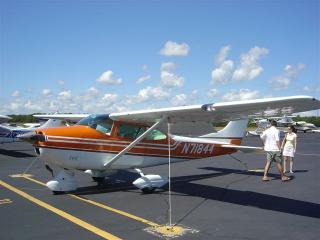The plane hit the ground in a spot that leads me to believe that he was preparing to turn from the downwind leg to the base leg of the traffic pattern for Runway 28 at East Hampton Airport (KHTO). There may have been an issue with an engine, but this would not be fatal in a twin engine plane. It seems far more likely that he stalled the wings (i.e., put the plane in an attitude where the wings were no longer creating lift) while making too steep a turn from downwind to base at a slow speed. We won't know for six months, but I suspect loss of control in low-level, slow maneuvering will be the cause. The press always focuses on engine failure, but that is not, generally, what causes fatal accidents.
KHTO is where I learned to fly and where I base my plane during the summer. Here she is on the ramp at East Hampton:

East Hampton Airport is a truly wonderful place to fly. The main runway is very long, but there is no control tower. All pilots talk on 122.7, the common traffic frequency. The terminal is small and friendly.
So, it pains me to think of that familiar view, turning base for Runway 28, suddenly rushing up at me with fatal fury.
7 comments:
So once you've gotten your plane into a situation where you've lost lift, what do you do?
Is it the loss of lift that essentially causes the loss of control? Do you increase power to the engines, or is it too late?
Chris -
When you stall the wings, you need to push the nose down so that the angle between the wind and the wing is decreased. If he was in the pattern, he was probably descending from 1,000 to 800 feet. In a turn, it would have been very hard for him to recover in enough time.
Decreasing the angle between the wing and the wind - like pulling in a sail on a sailboat?
So to get lift back you push the nose down, but there isn't enough time to get sufficient lift before the ground is there. Obviously at higher altitude you decrease this angle until your lift is back and everything's OK.
It seems like there's no solution at low altitude. So how do you prepare? Can you foresee situations that cause the loss of lift, is it predictable enough, or is there an element of chance on every approach?
This seems like a big flaw...
Chris -
The answer is to maintain control of the plane and not get yourself into an aerodynamic stall situation. This is why you must monitor your airspeed closely when in slow flight. In windy situations, you should add a few knots of airspeed when you are in the pattern.
The situation is made more difficult because these light twin engine planes are not too stable. If you lose an engine, the asymmetrical thrust makes it hard to maintain control.
I don't know for a fact that this is what happened, but I'd say the odds favor this explanation.
Tony - You are right, this is way too low for a parachute. If you are talking about a parachute for the whole plane, I can only assume your brother-in-law has a Cirrus SR20 or SR22. The plane parachute is interesting, but would not have helped in this scenario.
There is no doubt that it is a more dangerous hobby than most, but you always have the choice over what risks you will take. That's probably why Commercial pilots (these are not airline pilots, those are Air Transport-rated pilots) have the highest accident rate. They are not as heavily trained as airline pilots and they are often pressured by business reality into taking flights that are too risky.
For me, I try only to fly when it will be pleasant. I also try not to put myself into situations where I have to fly.
Damn... somebody beat me to the "Who's the hot girl in the plane photo?" entry
Dave
Close but no cigar. This is a classic stall spin as the result of an engine failure and the inability of the pilot to keep the aircraft under control with rudder. Once the airplane gets slow it is very difficult to regain speed without descending. Cessna 411’s are not particularly overpowered. Many private pilots have crashed in the same scenario. If you hold a multi engine certificate, you have to get recurrent training at a minimum once a year to ensure that you can recognize an engine failure and step on the correct rudder to maintain control. Due to limited power, most light twins are very unforgiving of a mishandled asymmetrical power failure.
Dan
P.S. to LinusMinus
The girl seems average to me.
Post a Comment